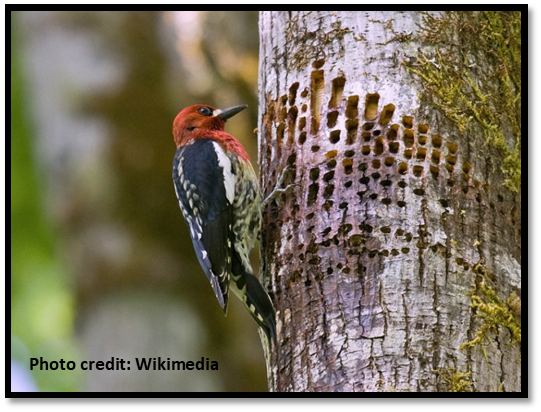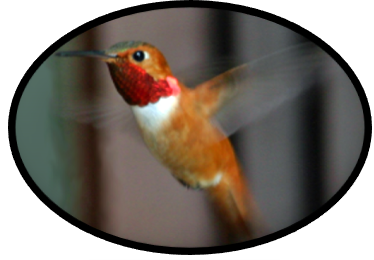By Kim Maley, Park Interpreter
Yellow-bellied sapsucker
Once upon a time there was a woodpecker named the yellow-bellied sapsucker (Sphyrapicus varius). Sporting red, black, and white plumage and, you guess it, a yellow tint to the belly, this woodpecker was widely distributed throughout North America. Or so we thought…
There was known to be a woodpecker subspecies with a red throat that lived out west that filled the same ecological role as their eastern counterparts. Scientists generally agreed to “lump” these into the same taxonomy classification as the yellow-bellied sapsuckers.
“Hey wait!”, cried the Splitters. They argued for a re-classification to split the birds into two separate species based on significant differences - a red throat for one.
Red-breasted sapsucker
Sphyrapicus ruber
The conflict waged on.
In 1983 the Lumpers conceded and the Splitters were declared the winner! Sphyrapicus ruber are now recognized as the red-breasted sapsucker.
Emboldened by their success, the Splitters looked with a critical eye to the woodpeckers in the Rocky Mountain/Great Basin region and noticed that the red plumage did not extend as far down to the bird’s breast. Another split resulted in the classification of the red-naped sapsucker (Sphyrapicus nuchalis).
YOU ARE WHAT YOU EAT
This is partly the case with sapsuckers. Sphyrapicus means sap-sucker and indeed, tree sap is a main component of the red-breasted sapsuckers’ diet. Formica ants, beetles, and other insects, fruit and seeds, and even cambium round out the diet. A study showed 68% of the red-breasted sapsucker diet to be insects (Beal, 1911). One source suggested woodpeckers have been known to dip their captured insects in sap wells before consuming!! (?)
THE RIGHT TOOL FOR THE JOB
My favorite topic - adaptations! From head to toe, woodpeckers are equipped with some pretty cool adaptations that allow them to succeed. Read on to learn a little bit about 4 of my favorite woodpecker adaptations!
CHISELED BEAK: THE WOODPECKER MULTI-TOOL
Essential for getting food, home-building, and even communication, this specialized beak is the signature feature of the woodpecker:
Sap Wells:
Photo Credit: Greg Gillson
Look closely at the trees on your next visit to the forest. See any with patterns of small holes? These are sap wells and are the work of careful planning! Neat rows of wells are drilled into the xylem layer of the tree (where the sap is) in order to divert the flow of some sap to the outside of the tree for easy access. Once the flow has been started, the wells are frequently revisited to feed.
Rufus hummingbird
Rufus hummingbirds are ecologically linked to these woodpeckers. They cleverly befriend the red-breasted sapsucker in order to enjoy the flowing sap as well! This is especially important to migrating hummingbirds looking for food before nectar-rich flowers have bloomed.
Knock on Wood:
An equally important use of that chiseled beak is communication! Drumming is the iconic woodpecker behavior of rapidly pecking on an object in patterns that communicate messages such as declarations of territory or mating interest. Perhaps some of you have experienced this on your metal chimney caps or lampposts.
At a mere 18 drums per second, the red-breasted sapsucker has a relatively slow drum in the world of woodpeckers. Before scoffing at these little guys for not being faster, try this little experiment: count how many seconds it takes to tap your finger on a surface 18 times.
Extreme Home Makeover: Dead Tree Edition
The third use of the chiseled beak is construction tool. Dead standing trees (snags) are prime real estate to a woodpecker! And woodpeckers fill an essential ecological role as Excavators of the Forest by creating nest cavities in these dead trees.
2. zygodactyl feet
pronounciation [zy-go-DAC-til] - one of the most fun words in nature!
These x-shaped feet with two forward facing toes and two backward facing toes allow the red-breasted sapsucker to easily stand on a vertical tree while excavating their nest, slurping that sap, or accomplishing any other woodpecker tasks.
Stiff tail feather provide added support and leverage.
Note: Woodpeckers are not the only birds at Silver Falls with zygodactyl feet. Owl perch using a zygodactyl pose, though they are able to pivot one of their back toes forward for hunting purposes.
3. Built-in safety equipment:
Sawdust flying everywhere! How safe can that be when the ‘drill’ used to create your nest cavity is on your face! Nature is smart though. Adaptations have evolved to protect those woodpecker eyeballs in the form of built-in goggles called nictitating membranes. These are basically a third eyelid that is translucent. Nictitating membranes are also found in several other Silver Falls’ residents including beavers, snakes, and owls.
Bonus safety gear: Nose feathers cover the nostrils to protect against inhalation of flying sawdust! (See photo above)
4. Super tongue:
Woodpeckers have ridiculously long tongues. An ingenious design, this adaptation serves a dual purpose as both fishing line and bubble wrap.
Pictured here is a Pileated woodpecker; though all woodpeckers have long tongues
Photo Credit: Mark Averitt
“Tap-tap-tap”. “Tap-tap-tap”. You may have noticed a red-breasted sapsucker tapping sporadically on a dead tree. Much like tapping on a wall to locate a stud, the woodpecker uses the chiseled beak to locate nests full of juicy insects or larvae. Once found, the woodpecker drills into the tree to reach the nest and extends a disproportionately long tongue with stiff barb-like hairs on the end into the hole much like a fishing line with a hook!
Sapsuckers tongues can extend 3 times the beak length! Which of course begs the question, where do they store such a long tongue when not fishing for grubs?!
The answer: when not in use the tongue wraps around the brain to undoubtedly protect against what, at best, would be a constant headache from all the drilling and drumming all day!
Distribution Map of the red-breasted sapsucker (Sphyrapicus rubus)
Silver Falls is home to 5 species of woodpeckers:
Red-breasted sapsucker
Pileated woodpecker
Northern flicker
Hairy Woodpecker*
Downey Woodpecker*
*Current Lumpers and Splitters are in discussions over whether Downey and Hairy woodpeckers are actually the same bird and therefore should be lumped into the same classification. Stay tuned for the ever-changing world of taxonomy!
Want to know more about woodpeckers?
Check out these additional references/resources:
Stephen Shunk (2016). Peterson Woodpeckers. Houghton Mifflin Harcourt Publishing Company
https://www.audubon.org/field-guide/bird/red-breasted-sapsucker
https://birdsoftheworld.org/bow/species/rebsap/cur/introduction
Beal, F.E.L. (1911). Food of the woodpeckers of the United States. US Department of Agriculture, Biological Survey Bulletin 37.














